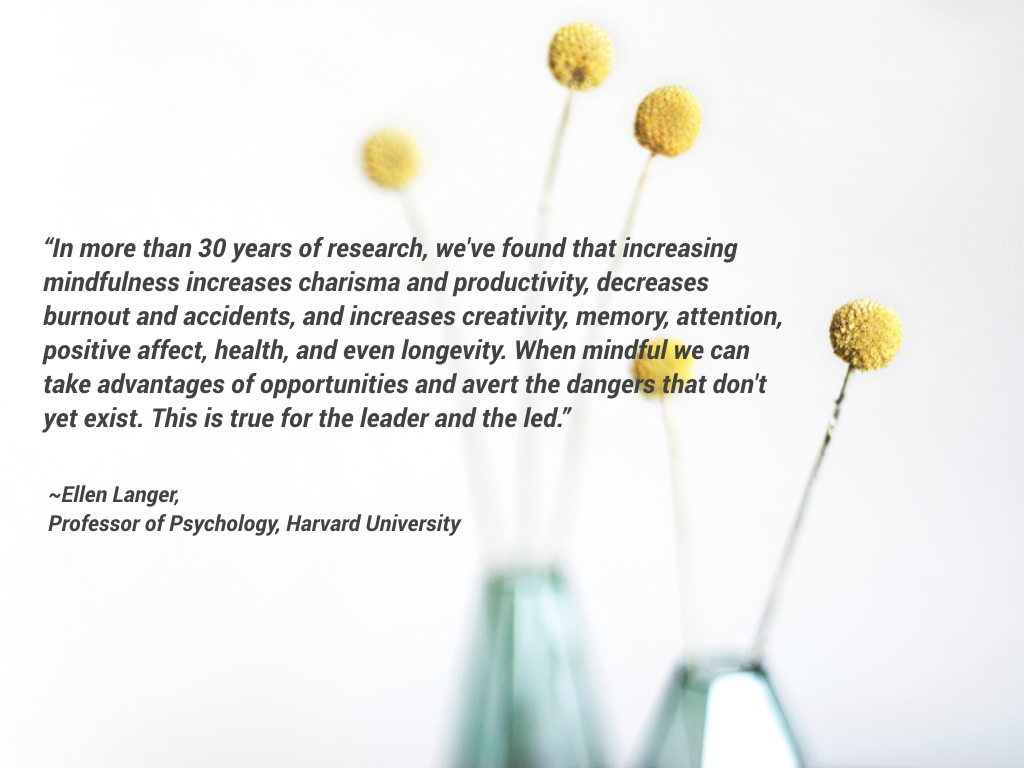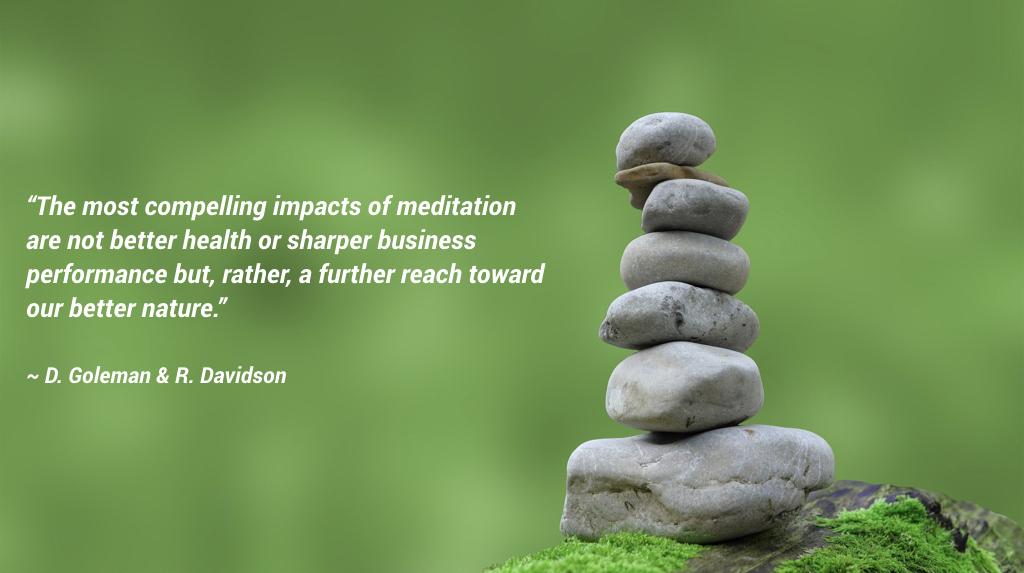ABOUT MINDFULNESS
It is taught and practiced in workplaces, schools, governmental organizations, in medical and paramedical fields; from athletes and champions to individuals with delinquent behavior, navy seals, military populations and the list goes on.
People who train in mindfulness essentially learn how to relate better with their own selves, with others, and, with potentially challenging situations.
Mindfulness can be thought of as a study into self-knowledge, or intrapersonal intelligence, i.e. the manner in which we deal with events appearing in the external as well as our internal world.
The basic road to mindfulness is through meditation, a practice met in the history of humanity across thousands of years. Meditation enables the cultivation of certain mental qualities which, although present in everyone as part of our “hardware”, may be in a dormant, latent state: clarity of thought, equanimity and value-based, purposeful action.
MINDFULNESS TODAY
Mindfulness is so popular that a simple Google search brings up over 70 million results. Many of these are linked with academic institutions, a fact reflective of the academic community’s interest in this practice. However, mindfulness hasn’t always been popular with academia and it certainly is not a scientific discovery.
Mindfulness is an ancient practice which can be found in various forms across humanity’s various religious systems. In its long voyage through the ages, through countless scriptures and experiences, mindfulness meditation reached our modern times, where, through the labors of a few inspired minds, it caught up with contemporary thinking and technology.
At the end of the 1970s, a few daring and somewhat unconventional scientists began studying the changes that occur in the human brain with mindfulness practices. From their work, which continues to this day, arose the nucleus of the scientific mindfulness community, comprising of internationally recognized university research centers and experts.
With the fairly recent technological advances that allow for in vivoobservation of brain activity and physiology (fMRI, EEG, etc.), interest in mindfulness practices has grown exponentially so that today, mindfulness has become a scientific ‘movement’. Thus from the 1970s to this day, publication has gone from a handful of papers/ year to over 1000 articles annually; in 2016 alone, 1,113 scientific papers on mindfulness were published in peer-reviewed journals.
Nowadays, labs equipped with state-of-the-art imaging technologies demonstrate the beneficial contribution of mindfulness in our well-being and quality of life, revealing how brain function changes in mental skills like concentration, resilience to stress, compassion and more.

MINDFULNESS IS
The most popular and widely accepted definition of mindfulness is by Jon Kabat-Zinn:
“Mindfulness is awareness that arises through paying attention, on purpose, in the present moment, non-judgmentally, in the service of self-understanding and wisdom. It’s knowing what’s on your mind.”
As Kabat-Zinn says, Asian languages have one single word for ‘mind’ and ‘heart’. So, in order to render the concept of mindfulness more fully, the word we need to add is ‘heart’: the feeling of kindness and compassion that can allow us to learn and grow from our experiences.
In scientific terms, mindfulness can be described as a deliberate exercise in the two dominant ways our brain has for processing reality: focus and awareness.
People who train in mindfulness essentially exercise their brains and therefore their central nervous system. They learn to focus their attention, observing all the while when and how they may get distracted. The fundamental goal of these practices is to bring both mind and body of the practitioner to the present moment, in order to proceed with greater clarity as to one’s intended action. During the course of training, practices correspond to specific cognitive skills that pertain to a more flexible and effective mode of living, skills like compassion, understanding, resilience and equanimity. On a neuro-biological level, practicing mindfulness is reflected in a more integrated functioning of the central nervous system.

MINDFULNESS IS NOT
The term ‘McMindfulness’, coined a few years back, vividly describes the way in which mindfulness practices may be promoted and exploited in today’s brand-centric culture.
Like the mindfulness scientific community, we are also keen to inform our clients that mindfulness training does not work like a ‘miracle pill’ that, once tried, will instantly provide them with leaps of concentration and efficiency, a super-energized brain, magically improved relationships and a complete immunity to stress.
Given the proven results, it’s understandable that some entrepreneurs choose to present their work as a panacea against stress or anxiety that makes the brain function better, giving complete control. For example, rigorous studies show that after just 8 minutes of mindfulness practice, measurable change can be observed with regard to specific behavioral criteria as well as brain activity, as far as concentration is concerned. However, in order to make these changes permanent, that is to say to achieve a more integrated functioning of the central nervous system, supporting the structural, functional and behavioral changes mentioned, considerably more than 8 minutes of practice are required. Mindfulness practices have the power to transform our experiences not just briefly but on a long term basis. This long term transformation is what we aim to offer our clients.
Mindfulness is not a miracle pill. Just like any new behavior one wishes to adopt, one needs the corresponding attitude, intent and proper practice.
A positive intent activates the self-discipline required to practice mindfulness, which will in turn bring about the corresponding behavioral changes. These changes are ‘stored’ in the brain, enhancing neuronal circuitsand thus differentiating CNS functioning and the way in which it affects and is affected by the rest of the human body.

NEUROSCIENCES AND MINDFULNESS
Mindfulness comes from ancient contemplative traditions whereby practitioners, through self-exploration of the mind, develop specific mental skills.
Today, meditation, the core of mindfulness, has been secularized, disengaged from the religious traditions to which it is related, and scientifically being studied just like all other mental qualities, that is, with objective criteria and evidence-based, reliable and valid methods.
The term ‘Contemplative neuroscience’ refers to the specific sector of neurosciences which, through of imaging technlogies such as functional nuclear magnetic resonance (fMRI), studies the effects of meditation on the human brain and the central nervous system (CNS).
Mindfulness training programs, like the ones we offer, employ various meditation techniques, each having a different action and effect on different aspects of mental functioning and consequently on specific behaviours. Regarding the benefits and changes observed through mindfulness practice, the following can be mentioned:
- Improvement in concentration and focus: the ability to remain concentrated on the task at hand is one of the most highly confirmed findings of neuroscientific studies.
- Resilience to stress: the ability of our CNS to return to normal levels of functioning after a stressful event appears to be increasing, especially in long-term mindfulness practitioners.
- Our capacity to understand people and support them in times of difficulty, i.e. put ourselves in their shoes while maintaining our composure — also seems to improve on a neuronal and behavioural basis.
- On the biological level, there is a reduction in the inflammatory response often caused by stress in the body, as well as increased activity in the enzyme telomerase, involved in inhibiting cell aging.
As Daniel Goleman and Richard Davidson, two of the most celebrated representatives of the mindfulness scientific community write, however, in their book Altered Traits:




